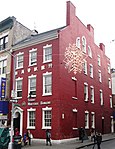Doyers Street
Chinatown, ManhattanStreets in ManhattanUse mdy dates from May 2020

Doyers Street is a 200-foot-long (61 m) street in the Chinatown neighborhood of Manhattan in New York City. It is one block long with a sharp bend in the middle. The street runs south and then southeast from Pell Street to the intersection of Bowery, Chatham Square, and Division Street. Doyers Street contains several restaurants, barber shops, and hair stylists, as well as the Chinatown branch of the United States Postal Service. The Nom Wah Tea Parlor opened at 13 Doyers Street in 1920, and is still in operation; other longstanding business include Ting's Gift Shop at 18 Doyers which opened in 1957.
Excerpt from the Wikipedia article Doyers Street (License: CC BY-SA 3.0, Authors, Images).Doyers Street
Doyers Street, New York Manhattan
Geographical coordinates (GPS) Address Nearby Places Show on map
Geographical coordinates (GPS)
| Latitude | Longitude |
|---|---|
| N 40.714354 ° | E -73.998102 ° |
Address
Doyers Street 7
10013 New York, Manhattan
New York, United States
Open on Google Maps





